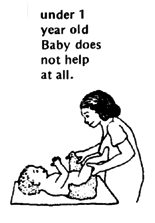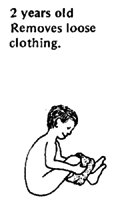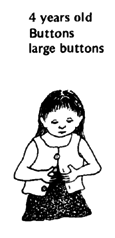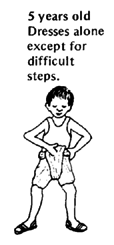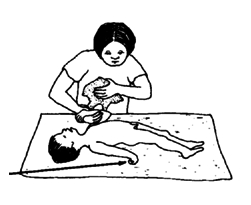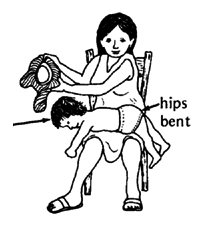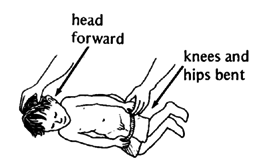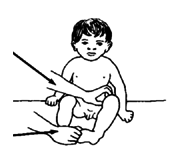CHAPTER 37
Dressing
![]()
Children with disabilities, like other children, should be encouraged from an early age to help with their own dressing. It is important, however, not to push a child to learn skills that are still too difficult for her level of development.
| AVERAGE AGE WHEN NON-DISABLED CHILDREN DEVELOP DRESSING
SKILLS
|
Children may learn dressing skills at different ages depending on local customs and on how much importance parents give to learning these skills. Observe what other children in your village can do at different ages. Children may begin to take off their clothes before they are 2 years old, yet may not learn to put on all their clothes correctly until they are 5 or 6 years old. Often a normal 6-year-old may put a shirt on backward, or the left sandal on the right foot.
Children who are slow in their development or who have difficulty with movements may be slower to learn dressing skills. It may seem quicker and easier for mother or sister to simply put the clothes on her, without interacting with the child. However, this will only delay the child's development more.
It is important to use dressing as an opportunity to help the child develop in many areas at once: awareness, balance, movement, and even language.
As you dress the child, talk to her. Help her learn her body parts the names of clothes, and the way these relate: "The arm goes into the sleeve," "The foot goes into the pants," and so on. This will help the child begin to learn language and connect parts of her body to her actions and things around her.
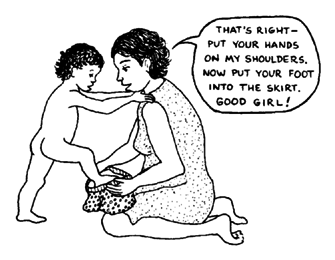
Helping the child gain dressing skills takes time and patience. Let her try to do as much as she can for herself. Be ready to help if it gets too difficult, but only as much as is needed. It is not good to frustrate the child so much that she will not want to try again. Be sure the task is not too advanced for the child's level of development.
![]()
POSITIONS FOR DRESSING
Try dressing the child in different positions, to see what works best.
| Body position is especially important when dressing a child
with spastic cerebral palsy. Often his body tends to bend
stiffly backward if he is dressed lying on his back. A bad position: (child's body stiffens backward) Hand bends tightly.
|
| It often works better to dress a child with spasticity
with his body and hips bent forward. A good position: face-down over lap
|
| For changing that needs to be done face-up,
try putting a firm pillow under the head, and keep knees and
hips bent. This may help the baby relax and not stiffen up.
|
| Lying on the side is often a good position
for a child with spasticity who is beginning to dress himself.
He may need to roll frm one side to the other to pull on clothes
- but he should keep his knees, hips, and head bent to avoid
stiffening.
|
| To help the child dress while sitting,
be sure he is in a steady position. You can help him keep his
hips bent and body forward like this.
If balance when sitting is still not good, or if the child tends to stiffen backward, try sitting in a corner to dress. |
|
| Sitting with the feet forward and knees apart is
a good position for play and dressing. If legs press together
stiffly try pushing the knee out gently while you press underthe
big toe.
|
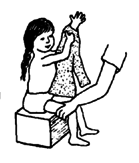
When a child with athetoid cerebral palsy tries to raise her arms or to speak, her feet may come off the ground or her legs spread.
Try pressing down over the knees keeping them together. Or press on top of the feet.
Help the child find the position that allows the best control for dressing.

SUGGESTIONS FOR DRESSING
![]()
| If one arm or leg is more affected than the other, it is easier if you put the clothes first on the affected side. | |
| Put the clothes where the child can see and reach them easily, so he can help in any way possible. |

| If the arm is bent stiffly, first try to straighten it slowly, then put the sleeve on. (if you try to straighten it forcefully or quickly, it may become more stiff.) | |
| If the legs straighten stiffly, bend them gently in order to put on pants or shoes. |
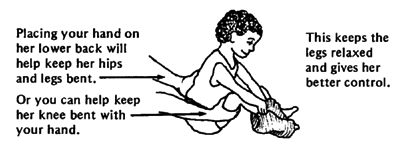
| Begin any dressing activity for the child, but let him finish it for himself. Little by little have him do more of the steps. If he can do it all by himself, give him time. Do not hurry to do it for him if he is struggling to do it himself. Praise him when he does well or tries hard. | |
| Use loose-fitting, easy-to-put-on clothing. Here are some ideas |
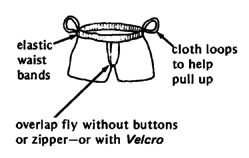
|

|
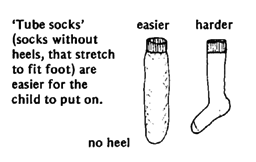
|
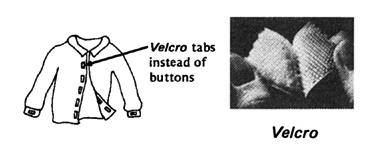
|
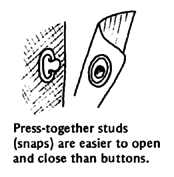
|
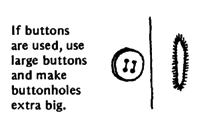
|
| For children who have poor finger control, make a simple tool to button and unbutton buttons. |
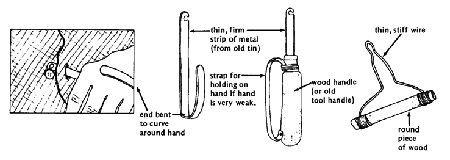
| For the child who often puts her dress on backward, or her sandals on the wrong foot, try to build in 'reminders' that will help her do it right. For example: |
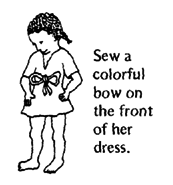
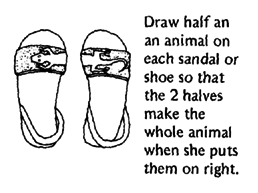
| For the child who has difficulty reaching his feet, a stick with a hook may help |

An all-purpose tool

Ideas for shoes

| For toes that claw up, or bend under, you can cut off the top of the shoe, or use a sandal. |
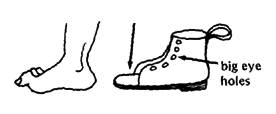
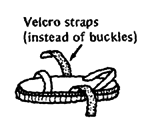
| Tennis shoes or other shoes that open all the way down to the toes are easier to put on. |
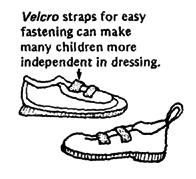
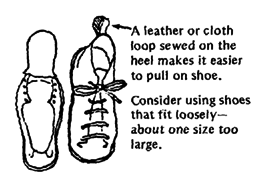
| If the fool stiffens downward so much it is hard to get a shoe on, you can cut the back of the shoe open and put the foot in from the back. |
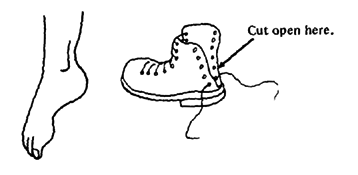
For special footwear designs for feet that do not feel,
see Page 224 and
225.
For shoe adaptations for braces, see Page
544.

